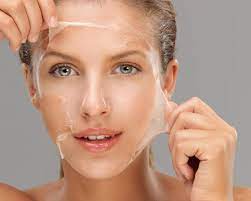Chemical Peel in Al Ain have become increasingly popular for their effectiveness in enhancing skin texture, tone, and overall appearance. These treatments involve the application of a chemical solution to the skin, causing it to exfoliate and eventually peel off. While chemical peels can deliver impressive results, it is crucial to understand the potential risks associated with the procedure. This article delves into the various risks of chemical peels, helping you make informed decisions about your skincare.
1. Understanding Chemical Peels
Before exploring the risks, it’s essential to grasp what chemical peels entail. There are three main types of chemical peels:
- Superficial Peels: These use mild acids, such as alpha-hydroxy acids (AHAs), to gently exfoliate the outer layer of the skin. They are often used to treat minor skin issues, such as fine lines and uneven skin tone.
- Medium Peels: These penetrate deeper into the skin, typically using trichloroacetic acid (TCA) to address moderate skin imperfections like sun damage and acne scars.
- Deep Peels: These use stronger chemicals, such as phenol, to target more severe skin issues. Deep peels can provide significant improvements but require longer recovery times.

2. Common Risks of Chemical Peels
a. Skin Irritation and Redness
One of the most common side effects of chemical peels is skin irritation. After the treatment, the skin may appear red, swollen, or sensitive. While this reaction is typically temporary, it can be uncomfortable and may last for several days.
b. Peeling and Flaking
As the name suggests, chemical peels cause the skin to peel. This process can be more pronounced with medium and deep peels, resulting in noticeable flaking. The extent of peeling varies among individuals and can affect one’s social activities, as the appearance of peeling skin may be undesirable.
c. Scarring
In rare cases, chemical peels can lead to scarring, particularly if the treatment is not performed correctly. Patients with a history of keloids or scarring may be at a higher risk. It is crucial to choose a qualified and experienced practitioner to minimize this risk.
d. Changes in Skin Pigmentation
Chemical peels can affect skin pigmentation, leading to either hyperpigmentation (darkening of the skin) or hypopigmentation (lightening of the skin). This risk is especially prevalent in individuals with darker skin tones. Those considering chemical peels should discuss their skin type with their practitioner to understand their risk.
e. Infection
Any procedure that involves the skin carries a risk of infection. After a chemical peel, the skin is more susceptible to bacteria, which can lead to infections if proper aftercare is not followed. It is essential to adhere to the aftercare instructions provided by the practitioner to minimize this risk.
3. Specific Risks Associated with Deep Peels
a. Prolonged Recovery Time
Deep chemical peels require a longer recovery period than superficial or medium peels. Patients may experience significant discomfort, redness, and peeling for weeks. This extended downtime can be inconvenient for individuals with busy lifestyles.
b. Allergic Reactions
Some patients may experience allergic reactions to the chemicals used in deep peels. Symptoms can range from mild irritation to severe reactions. A thorough consultation with a qualified practitioner can help identify potential allergens and minimize this risk.
4. Psychological Effects
While the physical risks of chemical peels are often discussed, it’s also important to consider the psychological effects. Patients may experience anxiety or disappointment if their results do not meet their expectations. Managing expectations and having open discussions with the practitioner about desired outcomes can help alleviate these concerns.
5. Mitigating Risks of Chemical Peels
To minimize the risks associated with chemical peels, consider the following tips:
- Choose a Qualified Practitioner: Selecting a licensed and experienced dermatologist or aesthetician is crucial. They can assess your skin type and recommend the appropriate type of peel.
- Follow Pre-Treatment Guidelines: Your practitioner may provide specific pre-treatment instructions to prepare your skin for the peel. Adhering to these guidelines can enhance your results and reduce risks.
- Discuss Medical History: Be open about your medical history, including any allergies or previous skin conditions. This information can help your practitioner tailor the treatment to your needs.
- Follow Aftercare Instructions: Proper post-peel care is essential for recovery. Follow your practitioner’s aftercare instructions to minimize the risk of complications.
6. Conclusion
Chemical peels can offer significant benefits for those seeking to improve their skin’s appearance. However, it is vital to be aware of the associated risks, including skin irritation, scarring, pigmentation changes, and potential infections. By choosing a qualified practitioner and following proper pre- and post-treatment care, you can enhance the safety and efficacy of your chemical peel experience in Al Ain.
FAQs
- How long does the peeling last after a chemical peel?
- Peeling duration varies by the type of peel but typically lasts between three to seven days for superficial peels and up to two weeks for deeper peels.
- Can I wear makeup after a chemical peel?
- It is advisable to avoid makeup for at least a few days post-peel to allow your skin to heal properly.
- What should I avoid after a chemical peel?
- After a chemical peel, avoid sun exposure, strenuous exercise, and harsh skincare products for at least one week.
- How often can I have chemical peels?
- The frequency of chemical peels depends on the type of peel used. Superficial peels can be done every few weeks, while deeper peels may be recommended once a year.
- Are there any alternative treatments to chemical peels?
- Yes, alternatives include laser resurfacing, microdermabrasion, and skincare treatments with active ingredients like retinoids or alpha-hydroxy acids.
- What are the signs of infection after a chemical peel?
- Signs of infection include increased redness, swelling, pus, or fever. If you experience these symptoms, contact your practitioner immediately.
- Is a chemical peel right for me?
- A consultation with a qualified practitioner can help determine if a chemical peel is suitable for your skin type and aesthetic goals.
